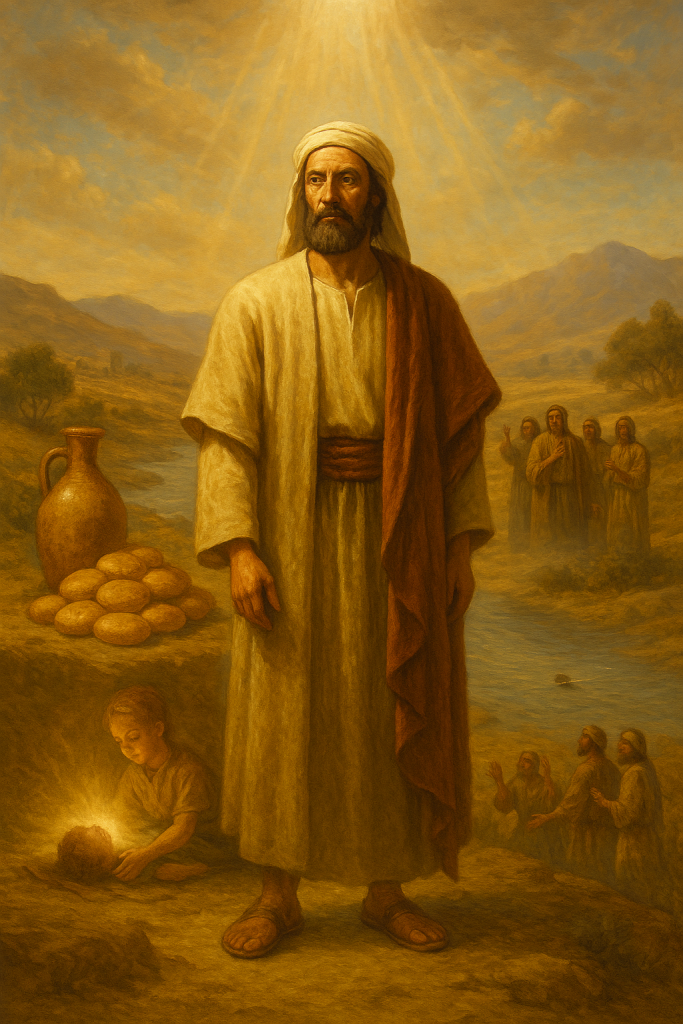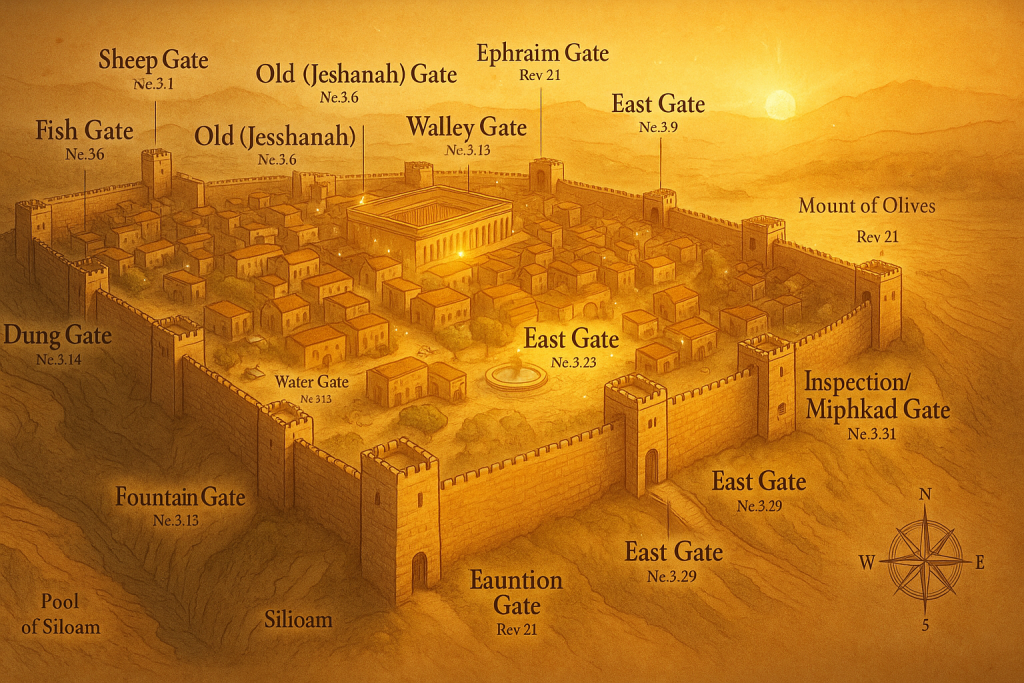Curious why so many readers search for the 32 miracles of Elisha? The count became popular because some guides include not only dramatic signs like multiplying oil, raising the Shunammite’s son, or making an axe head float but also fulfilled prophecies and acts of supernatural insight. Consequently, you’ll often see two traditions: lists that highlight 16 core miracle-episodes and expanded lists that detail 32 works associated with the prophet’s ministry.

32 Miracles of Elisha
In this article, you’ll find a clear, scannable overview: a complete list of the 32 miracles of Elisha with concise explanations, Bible references for quick verification, and thematic groupings such as provision, healing, justice, and revelation. Furthermore, we’ll explain why the totals vary, show how each episode fits the flow of 2 Kings, and offer balanced notes to avoid overclaiming where the text is brief.
Finally, moving from study to practice, you’ll see how these accounts can shape wise, everyday discipleship through prayerful discernment, compassion in action, and confidence in God’s care. Keep reading for a structured guide that helps you navigate the text, understand the themes, and apply them with humility and clarity.
Who was Elisha in the Bible
Elisha stands at the center of the 32 miracles of Elisha because his life threads together calling, training, and a long season of public ministry in Israel’s turbulent ninth century BC. First introduced in 1 Kings 19, he is called while plowing the fields of his family at Abel meholah. Elijah casts his cloak over him a symbolic act of succession and Elisha leaves oxen and land to serve as Elijah’s attendant, learning quietly before stepping into leadership.
His relationship with Elijah is pivotal. In 2 Kings 2, as Elijah is taken up, Elisha asks for a “double portion” of his mentor’s spirit a firstborn heir’s share in biblical language, signaling responsibility more than spectacle. Taking up the fallen cloak, Elisha crosses the Jordan and begins a ministry that touches city water supplies, rural households, royal courts, and international crises. That is the soil from which the well-known catalogue of signs grows.
Historically, Elisha ministers in the Northern Kingdom of Israel across several reigns (from the house of Ahab into the era of Jehu and beyond). This context includes border conflicts with Aram (Syria), internal instability, and ongoing idolatry. Elisha’s mission, therefore, is not limited to dramatic interventions; he offers counsel to kings, advocates for the vulnerable, and demonstrates God’s compassion through provision, healing, justice, and revelation.
In short, the prophet’s profile explains why the 32 miracles of Elisha span such diverse settings urban and rural, domestic and political and why readers encounter both powerful signs and wise guidance across the book of 2 Kings.
Read also our article about:
Biblical Meaning of Dreams.
Biblical Meaning For Numbers.
Double Portion: From Elijah to Elisha
When Elisha asks for a “double portion” of Elijah’s spirit (2 Kings 2:9–15), he is using the language of inheritance. In Israel, the double portion belonged to the firstborn (Deuteronomy 21:17), signaling succession, authority, and responsibility not a request for twice the spectacle. Elisha is asking to be Elijah’s true heir in the prophetic office, bearing the weight of leading God’s people amid political upheaval.
This background helps explain a long-standing comparison: many study guides attribute eight major miracles to Elijah and sixteen to Elisha often summarized as the “8×16” pattern. As readers move through 2 Kings, Elisha’s ministry expands across households, cities, and royal courts, which naturally yields more recorded acts of provision, healing, justice, and revelation.
How, então, surge a lista conhecida como 32 miracles of Elisha? Some compilers count not only power-events (like purifying Jericho’s water or raising the Shunammite’s son) but also fulfilled prophecies, strategic revelations (such as exposing enemy plans), and closely related episodes as distinct entries. This broader method doubles the familiar sixteen to thirty-two, offering a fuller map of Elisha’s God-given influence.
In short, the “double portion” frames Elisha’s role as rightful successor; the 8×16 tally highlights the expanded scope of his recorded works; and the 32 miracles of Elisha reflect an inclusive catalog that groups power-miracles, prophetic words, and revelatory interventions under one umbrella.
List of the 32 miracles of Elisha
Below is a clear, topic-based catalog of the 32 miracles of Elisha, each with a concise note and the biblical reference for quick verification.
Provision & Supply
- Water for three armies without rain — God fills the ditches, sustaining Israel, Judah, and Edom (2 Kgs 3:16–20).
- Moab confounded by “red water” — the sunrise makes the water appear like blood, triggering Moab’s miscalculation (2 Kgs 3:21–24).
- Widow’s oil multiplied — debt is paid and the family lives on the remainder (2 Kgs 4:1–7).
- Promise of a son to the Shunammite — provision of an heir in response to hospitality (2 Kgs 4:14–17).
- Poisoned stew made safe — the meal for the prophets is purified (2 Kgs 4:38–41).
- Bread multiplied for a hundred — a small gift feeds many, with leftovers (2 Kgs 4:42–44).
- Seven-year protection plan — warning about famine preserves the Shunammite household (2 Kgs 8:1–2).
- Providential restoration of land — timing and testimony lead the king to restore the woman’s property (2 Kgs 8:3–6).
Life & Death
- Shunammite’s child raised — God restores the boy to life (2 Kgs 4:32–37).
- Posthumous revival — a dead man revives when he touches Elisha’s bones (2 Kgs 13:21).
Healing
- Jericho’s spring healed — the city’s water and land are made wholesome (2 Kgs 2:19–22).
- Naaman cleansed of leprosy — the Aramean commander is healed after washing in the Jordan (2 Kgs 5:1–14).
- Gehazi smitten with leprosy — judgment falls for deceit (2 Kgs 5:20–27).
- Axe head made to float — lost iron is recovered from the Jordan (2 Kgs 6:1–7).
Judgment & Justice
- Bears at Bethel — a solemn judgment against mockery of God’s servant (2 Kgs 2:23–25).
- Prophecy of Moab’s defeat — God declares victory and devastation of enemy strongholds (2 Kgs 3:18–19).
- Siege-breaker prophecy — word of abundant grain despite Samaria’s famine (2 Kgs 7:1–2).
- Abundance fulfilled at the gate — prices collapse as the siege ends (2 Kgs 7:16).
- Officer’s doom foretold and fulfilled — the scoffer is trampled at the gate (2 Kgs 7:17–20).
Revelation, Guidance & Protection
- Jordan parted — Elisha crosses with Elijah’s mantle (2 Kgs 2:14).
- Recognition of prophetic succession — the sons of the prophets perceive that Elijah’s spirit rests on Elisha (2 Kgs 2:15) — confirming sign that frames the ministry.
- Strategic revelation of enemy plans — Elisha repeatedly discloses Aram’s ambushes (2 Kgs 6:8–12).
- Servant’s eyes opened — the mountain full of horses and chariots of fire becomes visible (2 Kgs 6:16–17).
- Arameans struck with blindness — the raiding party is neutralized (2 Kgs 6:18).
- Blind enemies led to Samaria — the hostile force is repositioned and then spared (2 Kgs 6:19–23).
- Cease of raiding bands — mercy shown to the captives leads to lasting relief (2 Kgs 6:23).
- Famine relief: full outcome — the prophetic word results in immediate, city-wide deliverance (2 Kgs 7:7–11,16) — the narrative’s outcome tied to Elisha’s earlier announcement.
Royal Counsel & Long-Range Prophecy
- Ben-Hadad’s fate foretold — Elisha predicts the king’s outcome in Damascus (2 Kgs 8:10).
- Hazael revealed and foretold as king — Elisha announces his rise and the coming devastation (2 Kgs 8:12–15).
- Commission for Jehu’s anointing — Elisha dispatches a prophet to install Jehu as king (2 Kgs 9:1–6).
- Arrow of the LORD’s victory — Joash receives a sign of triumph over Aram (2 Kgs 13:14–17).
- Limited victories explained — three strikes mean three wins; the scope is set by the king’s response (2 Kgs 13:18–19).
This topic-based map helps readers navigate the 32 miracles of Elisha across 2 Kings showing not only power-events, but also prophetic words, strategic revelations, and outcomes that God brings to pass in Israel’s history.
16 × 32: why the counts vary
When readers compare lists of Elisha’s works, two totals appear most often: 16 and 32. Both trace the same material in 2 Kings; they simply use different counting rules. Therefore, the difference is methodological, not contradictory.
The “16” approach
Many study guides focus on discrete miracle scenes—clear, observable acts of power tied to a single episode. Examples include purifying Jericho’s spring (2 Kgs 2:19–22), multiplying the widow’s oil (4:1–7), raising the Shunammite’s son (4:32–37), cleansing Naaman (5:1–14), and making the axe head float (6:1–7). In this method, closely connected moments within one episode are treated as one entry.
The “32 miracles of Elisha” approach
Expanded lists include prophetic declarations and revelatory interventions alongside the power-miracles. Consequently, fulfilled prophecies (e.g., the end of Samaria’s famine in 2 Kgs 7), strategic revelations (exposing Aram’s ambushes in 6:8–12), royal counsel with specific outcomes (the arrow of victory in 13:14–19), and even posthumous impact (13:21) may each be counted as separate items. Some compilers also separate multi-part outcomes within one storyline such as the prediction and its fulfillment raising the tally from 16 to 32.
How to read both lists without confusion
- Scope: The 16-entry method catalogues core power-acts. The 32-entry method maps the full range of Elisha’s God-given influence power, prophecy, guidance, and outcome.
- Structure: Single episodes vs. episode + word + outcome counted individually.
- Use case: Quick overviews often prefer 16; comprehensive studies and teaching outlines often prefer 32.
In short, the 32 miracles of Elisha expand the lens to include spoken words God brings to pass and moments of supernatural insight not only dramatic signs. Read with this in mind, both totals lead you through the same biblical terrain, just with different levels of zoom.
Read also our article about: Meaning of Animals in Dreams Biblical.
Key themes in Elisha’s miracles
The 32 miracles of Elisha trace a consistent pattern of who God is and how He cares for people in real situations. Seen together, these episodes highlight five themes that guide wise reading and practical application today.
1) Provision: God meets tangible needs
From multiplying oil (2 Kgs 4:1–7) to feeding a hundred with leftovers (4:42–44), provision runs through Elisha’s ministry. These signs teach stewardship, hospitality, and trust during scarcity. In practice, generosity and prudence are not opposites; they work together when needs press in.
2) Compassion: care for the vulnerable
Elisha serves widows, households under debt, and a grieving mother whose child is restored to life (4:32–37). Compassion here is not sentiment it is action informed by faith. Consequently, readers learn to combine prayer with concrete help, especially toward those with limited power or resources.
3) Justice and judgment: God confronts what harms
Some accounts carry a sober edge: discipline at Bethel (2:23–25), exposure of deceit (5:20–27), and words that break oppressive sieges (7:1–20). Justice in these scenes protects communities, restrains arrogance, and warns against exploiting spiritual gifts for personal gain. Therefore, reverence and integrity are not optional; they are essential.
4) Prophetic authority: truth that directs history
Elisha’s counsel to kings (6:8–12; 8:10–15; 9:1–6; 13:14–19) shows that God’s word is not theoretical; it shapes outcomes. Prophetic authority is measured by faithfulness and fulfillment, not spectacle. As a result, discernment today begins by weighing claims against Scripture, character, and fruit over time.
5) Posthumous signs: God’s power is not limited by human lifespan
The revival connected to Elisha’s bones (13:21) underscores a simple point: the source of power is God, not the prophet’s presence. This teaches humility about instruments and confidence in the One who works through them before and after any single life or season.
What these themes teach us
Taken together, the 32 miracles of Elisha invite balanced discipleship: trust God for provision, practice compassion, uphold justice, respect the weight of truthful speech, and remember that divine power is never confined to our timing. Read this way, the text fosters courage and humility two virtues that travel well in uncertain times.
Read also our article about: Biblical Meaning of the Number 29.
Practical applications today
The 32 miracles of Elisha do more than recount ancient wonders they model how faith, wisdom, and compassion can guide daily choices. Each miracle invites reflection and response, turning study into action.
1) Prayer: seek divine perspective first
Before decisions or challenges, Elisha consistently turned to God for direction (2 Kgs 6:17; 19:15). Prayer reorients the heart, helping believers focus on God’s power instead of fear or control.
2) Discernment: listen before acting
Elisha’s discernment knowing when to speak, intervene, or wait shows that spiritual insight grows with humility. Today, this means weighing motives, checking Scripture, and seeking wise counsel before reacting impulsively.
3) Wise counsel: guide others with integrity
The prophet advised kings and ordinary people alike. True counsel uplifts, clarifies, and never manipulates. If words do not bring peace or wisdom, it’s time to pause and pray again.
4) Service to others: faith expressed through care
Most of Elisha’s miracles met human needs food, health, safety, or justice. Modern application begins the same way: look for needs nearby and serve with consistency rather than spectacle.
Quick spiritual checklist inspired by Elisha:
- Pray before planning.
- Act with compassion, not pride.
- Speak truthfully, even when it’s difficult.
- Stay generous in scarcity.
- Remember that God’s power works through quiet obedience as much as through dramatic signs.
The 32 miracles of Elisha remind readers that divine power still flows through humble lives rooted in prayer, discernment, and service principles as relevant now as they were in the days of the prophet.
Frequently Asked Questions (FAQs)
Yes according to many Bible commentators, Elisha’s ministry included twice as many recorded miracles as Elijah’s. This fulfills the “double portion” request from 2 Kings 2:9, when Elisha asked for a greater share of his mentor’s prophetic spirit. The 32 miracles of Elisha represent that expanded influence, not as competition, but as a continuation of God’s power through faith and obedience.
The shorter count groups related events together for example, a prophecy and its fulfillment are counted as one. The 32 miracles of Elisha version, however, treats each divine action or fulfilled word separately, highlighting the prophet’s broader spiritual impact. Both methods reflect the same biblical record; they simply organize it differently.
Several episodes stand out for their vivid imagery and deep lessons:
Healing the waters of Jericho (2 Kgs 2:19–22).
Multiplying the widow’s oil (4:1–7).
Raising the Shunammite’s son (4:32–37).
Cleansing Naaman from leprosy (5:1–14).
Making the axe head float (6:1–7).
The posthumous resurrection linked to Elisha’s bones (13:21).
Each of these displays compassion, divine authority, and the reminder that God’s power transcends time, status, and circumstance.
Start with prayer and context read each story in 2 Kings with attention to who is helped, what is taught, and how faith is strengthened. Reflect on patterns of mercy, justice, and provision.
Through these questions, the 32 miracles of Elisha come alive not as distant wonders, but as enduring lessons in faith, humility, and the active presence of God in daily life.


